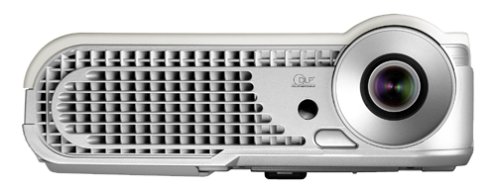Billed as the world's most affordable dedicated DLP home-theater projector at the time of its 2004 release, Optoma's HDTV-ready H30 DLP (Digital Light Processor) projector combines Double Data Rate DLP technology by Texas Instruments with a 4-speed, 6-segment color wheel for unsurpassed brightness, true colors, and absolute black levels, as well as the advanced scaling and deinterlacing technologies of Pixelworks.
View projector details (new window)
Ideal for nearly any room size or configuration, the H30 weighs in at a mere 4.6-pounds for easy stationary mounting or unobtrusive placement on a projector stand or table. And, despite its low weight and compact size, the H30 is exceptionally quiet at 32 dB (30 dB in economy mode). It comes equipped with a 180-watt, 2000-hour lamp (3,000 hours in economy mode), a convenient remote control, and is compatible with virtually every digital and analog source. It also provides high-demand inputs and outputs including a VGA input (analog RGB/component/HDTV), S-video, and a composite video (RCA)/VGA output.
A winner of the CES Innovations 2004 Video Design and Engineering Award, the projector's combination of technologies results in stunning image reproduction and smooth onscreen motion. It also provides sharp SVGA (800 x 600) resolution, an incredibly detailed 2000:1 contrast ratio, and a bright 800-lumens lamp. The H30 also offers a range of aspect ratios to accommodate different source materials and screen sizes ranging from native 4:3 to widescreen 16:9 dimensions. Dedicated DLP home-theater projectors with similar features retail for nearly twice as much, while comparatively priced business projectors are not optimized for home theater applications.
The projector accommodates screen sizes ranging from 29 to 260 inches (0.7 to 6.6 meters), has a projection distance of 4.1 to 32.8 feet (1.25 to 10 meters), a wide-range throw ratio of 1.75:1 to 2.12:1, and also provides keystone correction, manual zoom, and manual focus. Like many pricier projectors, the H30 offers an economy mode to prolong lamp life and reduce noise.
DLP technology uses an optical semiconductor, known as the Digital Micromirror Device or DMD chip, to digitally manipulate light. The chip contains a rectangular array of up to 1.3 million microscopic mirrors, each of which measures less than 1/5 the width of a human hair. A DMD panel's micromirrors are mounted on tiny hinges that enable them to tilt either toward the light source (on) or away from it (off)--creating a light or dark pixel on the projection surface. The bit-streamed image code entering the semiconductor directs each mirror to switch on and off up to several thousand times per second, such that the mirrors can reflect pixels in up to 1,024 shades of gray.
The white light generated by the lamp passes through a color wheel as it travels to the surface of the DMD panel. The color wheel filters the light into red, green, and blue, from which a single-chip DLP projection system can create at least 16.7 million colors. The on and off states of each micromirror are coordinated with these three basic building blocks of color. For example, a mirror responsible for projecting a purple pixel will only reflect red and blue light to the projection surface; our eyes blend these rapidly alternating flashes to see the intended hue in a projected image.
What's in the Box
Projector, AC power cord, composite-video cable, VGA-to-component-video adapter, S-video cable, a remote control, 2 remote batteries, a lens cap, a user's manual, and a warranty card.








0 comments:
Post a Comment